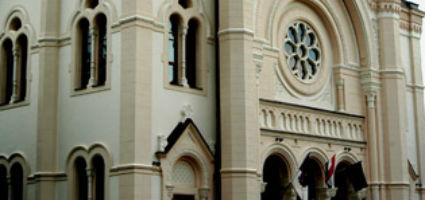2025. July 8. Tuesday
János Damjanich Museum - Szolnok Gallery - Szolnok
 |
Address: 5000, Szolnok Templom utca 2.
Phone number: (56) 513-640
E-mail: szolnokigaleria@externet.hu
Opening hours: Tue-Sun 9-17
|
The rebuilt Szolnok Gallery maintained by the Jász-Nagykun-Szolnok County Museums is situated in a building on the banks of the river Tisza, in one of the protected buildings of the town.
The building has not fulfilled its original function for long. Its new mission has been the location of exhibitions ever since the museum took it over from the local Jewish community. It has been one of the nicest places of exhibitions in the county.
The building was originally built as a Synagogue by the Jewish community of the town at the end of the 19th century. Baumhorn Lipót born in 1860 designed it. Baumhorn studied in Vienna and began his career by the architects Lechner Ödön and Pártos Gyula. He worked with them the next 12 years. The interest of Lechner in Eastern architecture can be traced in the works of Baumhorn who designed 19 synagogues in his life while he developed his individual style baring affects of secession. His most well-known design was the synagogue of Szeged.
The synagogue of Szolnok is situated on an estate surrounded by two roads; nevertheless, the emphasis is not on the walls facing the river Tisza. Luckily, all four walls are of the same high value and are spectacles of the town. The bust of Baumhorn, the composition of Simon Ferenc, is in front of the building.
The building is colored by coloring taken from natural material eg. granite, limestone and is surrounded by green trees.
The old wrought iron fence, however, could not be reconstructed. Still, it now surrounds the territory of the Colony of Artists of Szolnok, so, it is still part of the view of Szolnok.
During the reconstruction works, the facade was not modified significantly since the designer wanted to show its original looks. The facade is colored white and light mauve instead of yellow typical of the era of Maria Teresa.
The inner spaces remained unchanged. The inner walls are all white due to the decision of the Cultural Heritage Committee.
The original form of the floor was reconstructed by old photos by the specialists of the Primterv Designer Company and the contractors of the Túr-Szol Ltd. A Jewish star is located under the cupola suggesting the past of the building.
Two stone tablets on top of the Torah desk, originally belonging to the Synagogue, also suggest the original function of the building. Slim poles hold the gallery. A cupola at 26 m height closes the middle part. The ornaments both on the facade outside and inside bare Moorish elements.
The building is lit with a so-called intelligent lighting meaning that the objects are lit by a computer-operated system.
Szathmáry István
The building has not fulfilled its original function for long. Its new mission has been the location of exhibitions ever since the museum took it over from the local Jewish community. It has been one of the nicest places of exhibitions in the county.
The building was originally built as a Synagogue by the Jewish community of the town at the end of the 19th century. Baumhorn Lipót born in 1860 designed it. Baumhorn studied in Vienna and began his career by the architects Lechner Ödön and Pártos Gyula. He worked with them the next 12 years. The interest of Lechner in Eastern architecture can be traced in the works of Baumhorn who designed 19 synagogues in his life while he developed his individual style baring affects of secession. His most well-known design was the synagogue of Szeged.
The synagogue of Szolnok is situated on an estate surrounded by two roads; nevertheless, the emphasis is not on the walls facing the river Tisza. Luckily, all four walls are of the same high value and are spectacles of the town. The bust of Baumhorn, the composition of Simon Ferenc, is in front of the building.
The building is colored by coloring taken from natural material eg. granite, limestone and is surrounded by green trees.
The old wrought iron fence, however, could not be reconstructed. Still, it now surrounds the territory of the Colony of Artists of Szolnok, so, it is still part of the view of Szolnok.
During the reconstruction works, the facade was not modified significantly since the designer wanted to show its original looks. The facade is colored white and light mauve instead of yellow typical of the era of Maria Teresa.
The inner spaces remained unchanged. The inner walls are all white due to the decision of the Cultural Heritage Committee.
The original form of the floor was reconstructed by old photos by the specialists of the Primterv Designer Company and the contractors of the Túr-Szol Ltd. A Jewish star is located under the cupola suggesting the past of the building.
Two stone tablets on top of the Torah desk, originally belonging to the Synagogue, also suggest the original function of the building. Slim poles hold the gallery. A cupola at 26 m height closes the middle part. The ornaments both on the facade outside and inside bare Moorish elements.
The building is lit with a so-called intelligent lighting meaning that the objects are lit by a computer-operated system.
Szathmáry István